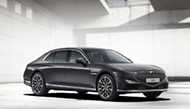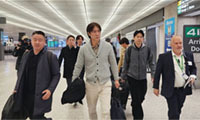Along with the living --- a chicken or piglet perhaps --- various things may be wedged at angles, including small refrigerators, potted plants, metal frames and bunches of bananas. Bikes, the cars of the newly affluent, and pedestrians weave around one another in a seamless pattern fashioned not by any rule or organizing principle but by individual awareness. Major intersections, unburdened by anything as cumbersome or inflexible as traffic lights, function as massive group exercises in tentative advance, the principle being to coax others to the prudence of the brake by nosing ahead with just the right dose of insistence. Lo, the sea divides. A path opens. There is no logic at work, but there is a great deal of humanity.
Madness might be a verdict on all this, but then to the average Vietnamese biker there might be equal madness to Western culture, hemmed in by all the controls that a combination of fear and technology produce. Surely there must be a happy medium between placing a toddler on the handlebars of a scooter and denying children the freedom to roam and discover that is essential to their development. Surely there is an appropriate balance between a free-for-all on the roads and a camera at every corner. But humanity tends to deal more in irrational exuberances than happy mediums. The pendulum swings too far.
In Britain, over-the-top safety obsessions have produced a society where cameras and so-called traffic-calming speed bumps are everywhere, visitors to churches and colleges are warned that medieval paving stones may be a little uneven, schoolchildren have been advised to wear goggles when using certain glues (and helmets under chestnut trees), trainee hairdressers are not allowed scissors in the classroom, and mail delivery gets suspended in an entire region if a postman slips and hurts his shoulder. David Cameron, the prime minister, spoke out five years ago against the health-and-safety culture that had produced “a stultifying blanket of bureaucracy, suspicion and fear that has saturated our country, covering the actions of millions of individuals.” Not much has changed.
Britain is only an extreme example of the broader phenomenon that can see the world’s greatest city, New York, shut down not by a snowstorm but by the possibility of a snowstorm (the blizzard that never happened); and the bizarre term “free-range parenting” applied to American moms and dads who believe their children should be allowed to walk home from school alone and play outside. Earlier this year a Maryland couple was found responsible for “child neglect” because they let kids walk home alone from a neighborhood park. Whatever happened to the land of the free and home of the brave?
I am not recommending that Western urban planners go to Vietnam to study traffic management. I am suggesting that developed Western societies, increasingly fear-driven, tend to fall into a nanny-state mind-set where health, safety and security must all be stringently regulated, adults are viewed as children, and the emotional intelligence of humanity is underestimated or discounted. To cross a highway in Saigon . perhaps with a wave here and there to remind onrushing scooters and cars of your existence . is to experience not just relief at reaching the other side, but wonderment at how unregulated people can work together.
The Dutch traffic engineer Hans Monderman was intrigued by this phenomenon. His “shared space” idea turned traditional thinking about road safety on its head. For much of the 20th century the assumption was that efficient traffic flow depended on a full separation of cars and pedestrians, complemented by traffic signals, signs, barriers and road markings that would keep people safe. The state took charge through regulation; the individual only had to obey instructions.
Monderman, who died in 2008, had other ideas. He wanted to raise collective awareness and responsibility by doing away with all that separateness, and he believed that safety might be increased by making all travelers intensely aware of one another. Cars, bicyclists and pedestrians would all move on a single curb-free surface, without sidewalks or signs. Sometimes he would test his schemes . developed in various Dutch, German and Scandinavian towns . by walking backward into dense traffic in a shared-space area. Of late the idea of “shared space” has even gained a foothold in London.
I recommend walking backward into a Saigon street, for the heck of it, but also to be reminded of the limits of regulation and the power of shared humanity.
스마터리빙
more [ 건강]
[ 건강]이제 혈관 건강도 챙기자!
[현대해운]우리 눈에 보이지 않기 때문에 혈관 건강을 챙기는 것은 결코 쉽지 않은데요. 여러분은 혈관 건강을 유지하기 위해 어떤 노력을 하시나요?
 [ 건강]
[ 건강]내 몸이 건강해지는 과일궁합
 [ 라이프]
[ 라이프]벌레야 물럿거라! 천연 해충제 만들기
 [ 건강]
[ 건강]혈압 낮추는데 좋은 식품
[현대해운]혈관 건강은 주로 노화가 진행되면서 지켜야 할 문제라고 인식되어 왔습니다. 최근 생활 패턴과 식생활의 변화로 혈관의 노화 진행이 빨라지고
사람·사람들
more많이 본 기사
- 박나래, 매니저 괴롭히고 술자리 강요..갑질 폭로, 피소 “확인 중”
- 로데오 갤러리아 건물주 ‘퇴거 통보 철회’
- 방탄소년단, 스포티파이 정상..글로벌 K팝 최다 스트리밍
- 아시아나 운항 감편 LA-인천 하루 1편만
- [안팎으로 옥죄는 이민 단속] ICE 대대적 이민 단속 확대
- 가주 등에 “푸드스탬프 지원 중단” 위협
- “AI 첨단기술로 한인타운 치안 강화”
- 박지성♥김민지 딸, 10살 된 근황..엄마도 놀란 폭풍 성장 “요래 됐습니다”
- 故김새론 유족 측, 카톡 포렌식 자료 공개 “김수현과 미성년자 교제 확실”
- 12월 4일은 방탄소년단 진의 날! 전 세계 팬들 광고·이벤트·기부..글로벌 초대형 생일 파티
- 진짜 몰라보겠다.. ‘미우새’ 홍진영 근황
- 79세 영국 귀족 공개구혼 ‘시끌’
- [안팎으로 옥죄는 이민 단속] ‘입국금지국’ 이민 전면 중단
- 11월 민간 고용 3만2,000명 감소
- 홍명보 감독, 조추첨 참석차 미 도착… “최상 시나리오 예측불가”
- 우크라 종전 협상 ‘빈손’ 푸틴… “유럽과 전쟁도 불사”
- 류현진·노경은·김도영 합류… 2026 WBC 1차 캠프 명단 확정
- 아마존, AI칩 첫 출시 엔비디아 등에 도전
- ‘즉시 입주 가능?’… 자칫 불량 ‘레몬 하우스’ 일 수도
- ‘전국 최다 해고’… 가주 경제 부진 지속
- “새인가, 비행기인가?”… 상공서 집 찍는 ‘AI 풍선’ 등장
- 주택보험료 2년간 16% 급등… 소유주들 ‘허리 휜다’
- 충청향우회·파바월드, 슈라이너 병원 후원
- 무인택시 웨이모 ‘아찔’… 경찰 대치현장 난입
- OKC 13연승 질주… 길저스알렉산더 38점
- 엔비디아, 지분 투자 반도체기업에 20억불
- 메트로시티 은행, 남가주 영업망 확장 ‘잰걸음’
- 부친 흉기살해 아들, 경찰 총에 사망
- [열린송현] ‘100년 만에 재설계’ 미 증시서 배우자
- 델 창업자, 63억달러 ‘통 큰 기부’
- ‘공립 프리스쿨’ 확대에 민간 시설 폐업 속출
- 트레이더조스 이어 코스코 토트백 ‘열풍’
- 우리 식탁과 주변의 보이지 않는 독성 물질, 프탈레이트
- 우남회 정기모임, 장학재단 설립 등 추진
- 트럼프 행정부, 차량 연비규제 완화
- 비트코인 급반등 성공 9만4,000달러선 돌파
- [윌셔에서] 크리스마스와 쌀 한 포대
- 금·은·구리 ‘트리플 랠리’ 45년만에 최고가 기록
- 투자·고정 지수 연금 어디에 맡길까?(1)
- ICE, 임신부 여성들도 체포·구금해 논란
- 한미은행, 버몬트·세리토스 지점 40주년 기념
- 저속 인생
- 단기 확정금리연금의 재조명
- 2026년 OC부동산시장 ‘급등은 없지만, 기회는 남아’
- 옥스포드대 출판부 선정 올해의 단어 ‘분노 미끼’
- [지평선] 페트리 접시 속 아리아나 그란데
- 연방정부, ‘한국차 관세 15%’ 관보 게재
- 美, 전문직 비자 심사 강화… “‘검열’ 관련 경력 있으면 부적격”
- [기고] 중가주 사적지 역사탐방을 마치고
- [왈가 왈부] 과학기술 기관장 줄줄이 공백… ‘과학 강국’은 헛구호인가요
1/5지식톡

-
 테슬라 자동차 시트커버 장착
0
테슬라 자동차 시트커버 장착
0테슬라 시트커버, 사놓고 아직 못 씌우셨죠?장착이 생각보다 쉽지 않습니다.20년 경력 전문가에게 맡기세요 — 깔끔하고 딱 맞게 장착해드립니다!장착비용:앞좌석: $40뒷좌석: $60앞·뒷좌석 …
-
 식당용 부탄가스
0
식당용 부탄가스
0식당용 부탄가스 홀세일 합니다 로스앤젤레스 다운타운 픽업 가능 안녕 하세요?강아지 & 고양이 모든 애완동물 / 반려동물 식품 & 모든 애완동물/반려동물 관련 제품들 전문적으로 홀세일/취급하는 회사 입니다 100% …
-
 ACSL 국제 컴퓨터 과학 대회, …
0
ACSL 국제 컴퓨터 과학 대회, …
0웹사이트 : www.eduspot.co.kr 카카오톡 상담하기 : https://pf.kakao.com/_BEQWxb블로그 : https://blog.naver.com/eduspotmain안녕하세요, 에듀스팟입니다…
-
 바디프렌드 안마의자 창고 리퍼브 세…
0
바디프렌드 안마의자 창고 리퍼브 세…
0거의 새제품급 리퍼브 안마의자 대방출 한다고 합니다!8월 23일(토)…24일(일) 단 이틀!특가 판매가Famille: $500 ~ $1,000Falcon: $1,500 ~ $2,500픽업 & 배송직접 픽업 가능LA…
-
 바디프렌드 안마의자 창고 리퍼브 세…
0
바디프렌드 안마의자 창고 리퍼브 세…
0거의 새제품급 리퍼브 안마의자 대방출 한다고 합니다!8월 23일(토)…24일(일) 단 이틀!특가 판매가Famille: $500 ~ $1,000Falcon: $1,500 ~ $2,500픽업 & 배송직접 픽업 가능LA…
케이타운 1번가
오피니언
 이상희 UC 리버사이드 교수 인류학
이상희 UC 리버사이드 교수 인류학 저속 인생
 클라라 원 대한인국민회 기념재단 이사장
클라라 원 대한인국민회 기념재단 이사장 [기고] 중가주 사적지 역사탐방을 마치고
 김승연 넥스트증권 대표
김승연 넥스트증권 대표 [열린송현] ‘100년 만에 재설계’ 미 증시서 배우자
 성민희 소설·수필가
성민희 소설·수필가 [윌셔에서] 크리스마스와 쌀 한 포대
 양홍주 / 한국일보 논설위원
양홍주 / 한국일보 논설위원[지평선] 페트리 접시 속 아리아나 그란데

[왈가 왈부] 과학기술 기관장 줄줄이 공백… ‘과학 강국’은 헛구호인가요
 정숙희 논설위원
정숙희 논설위원윤이상, 상처입은 용
 파리드 자카리아 워싱턴포스트 칼럼니스트 / CNN ‘GPS’ 호스트
파리드 자카리아 워싱턴포스트 칼럼니스트 / CNN ‘GPS’ 호스트 미국에서 영감을 얻는 세계의 독재자들
 김동찬 시민참여센터 대표
김동찬 시민참여센터 대표 [미국은 지금] 라칸왈의 총성, 반이민의 쇄국 될까
1/3지사별 뉴스

KCS 커뮤니티센터에 엘리베이터 설치된다
뉴욕한인봉사센터(KCS)는 2일 퀸즈 베이사이드 KCS 커뮤니티센터내 엘리베이터 설치를 위한 뉴욕주정부 예산 200만달러를 확보했다고 밝혔다.…
시민권자 이중국적 금지 추진⋯한인 복수국적자 ‘촉각’

DC 시장 각축전…최소 9명 도전
내년 워싱턴 DC 시장 선거를 앞두고 최소 9명 이상 출마할 것으로 예상된다.지난달 25일 뮤리엘 바우저 시장의 불출마 선언으로 차기 DC 시…
마크 워너 VA 연방 상원의원 4선 도전

美, 전문직 비자 심사 강화… “‘검열’ 관련 경력 있으면 부적격”
트럼프 행정부가 전문직 취업비자인 H-1B 비자 신청자가 ‘온라인 검열’ 관련 업무를 하지 않았는지 확인하기 위해 심사 강화에 나섰다고 로이터…
SF 베이지역 한인회, ‘2025 송년 감사 갈라 음악회’

오늘 하루 이 창 열지 않음 닫기 





















































.png)


댓글 안에 당신의 성숙함도 담아 주세요.
'오늘의 한마디'는 기사에 대하여 자신의 생각을 말하고 남의 생각을 들으며 서로 다양한 의견을 나누는 공간입니다. 그러나 간혹 불건전한 내용을 올리시는 분들이 계셔서 건전한 인터넷문화 정착을 위해 아래와 같은 운영원칙을 적용합니다.
자체 모니터링을 통해 아래에 해당하는 내용이 포함된 댓글이 발견되면 예고없이 삭제 조치를 하겠습니다.
불건전한 댓글을 올리거나, 이름에 비속어 및 상대방의 불쾌감을 주는 단어를 사용, 유명인 또는 특정 일반인을 사칭하는 경우 이용에 대한 차단 제재를 받을 수 있습니다. 차단될 경우, 일주일간 댓글을 달수 없게 됩니다.
명예훼손, 개인정보 유출, 욕설 등 법률에 위반되는 댓글은 관계 법령에 의거 민형사상 처벌을 받을 수 있으니 이용에 주의를 부탁드립니다.
Close
x